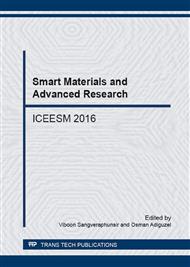[1]
Dubois V., Abriak NE., Zentar R. and Ballivy G. (2009). The use of marine sediments as a pavement base material. Waste Management, 29(2): 774-782.
DOI: 10.1016/j.wasman.2008.05.004
Google Scholar
[2]
Xu Y., Yan C., Xu B., Ruan X. and Wei Z. (2014). The use of urban river sediments as a primary raw material in the production of highly insulating brick. Ceramics International, 40: 8833-8840.
DOI: 10.1016/j.ceramint.2014.01.105
Google Scholar
[3]
Tangprasert W. (2012). Application of sediment from Lumsai canal with rice husks and rice straws to produce bricks. (senior project), Faculty of Science Chulalongkorn University. Bangkok (in Thai).
DOI: 10.7763/ijesd.2015.v6.593
Google Scholar
[4]
Samara M., Lafhaj Y. and Chapiseau C. (2009). Valorization of stabilized river sediments in fired clay bricks: factory scale experiment. Journal of Environmental Management, 163: 701-710.
DOI: 10.1016/j.jhazmat.2008.07.153
Google Scholar
[5]
Casado-Martínez M.C., Buceta J.L., Belzunce M.J. and DelValls T.A. (2006). Using sediment quality guidelines for dredged material management in commercial ports from Spain. Environment International, 32: 388-396.
DOI: 10.1016/j.envint.2005.09.003
Google Scholar
[6]
Collins R.J. (1980). Dredged silt as a raw-material for the construction industry. Resource Conservation and Recovery, 4 (4): 337-362.
DOI: 10.1016/0304-3967(80)90039-6
Google Scholar
[7]
Hamer K. and Karius V. (2002). Brick production with dredged harbour sediments an industrial-scale experiment. Waste Management, 22: 521-530.
DOI: 10.1016/s0956-053x(01)00048-4
Google Scholar
[8]
Karpuzcu M., Buktel D. and Aydin Z.S. (1996). The dewaterability, heavy metal release and reuse characteristics of Golden Horn surface sediment. Water Science and Technology, 34(7e8): 365-374.
DOI: 10.2166/wst.1996.0643
Google Scholar
[9]
Lafhaj Z., Samara M., Agostini F., Boucard L., Skoczylas F. and Depelsenaire G. (2008).
Google Scholar
[10]
Romero M., Andrés A., Alonso R., Viguri J. and Ma Rincón J. (2008). Sintering behavior of ceramic bodies from contaminated marine sediments. Ceramics International, 34: 1917-(1924).
DOI: 10.1016/j.ceramint.2007.07.002
Google Scholar
[11]
Torres P., Manjate R.S., Fernandes H.R., Olhero S.M. and Ferreira J.M.F. (2009). Incorporation of river silt in ceramic tiles and bricks. Ceramics International, 1: 5-12.
Google Scholar
[12]
Mezencevova A., Yeboah N., Burns S., Kahn L. and Kurtis K. (2012). Utilization of Savannah Harbor river sediment as the primary raw material in production of fired brick. Waste Management, 113: 128-136.
DOI: 10.1016/j.jenvman.2012.08.030
Google Scholar
[13]
Loryuenyong V., Panyachai T., Kaewsimork K. and Siritai C. (2009). Effect of recycled substitution on the physical and mechanical properties of clay bricks. Waste Management, 29: 2717-2721.
DOI: 10.1016/j.wasman.2009.05.015
Google Scholar
[14]
Tuan B.L.A., Hwang C., Lin K., Chen Y. and Young M. (2013). Development of lightweight aggregate from sewage sludge and waste glass powder for concrete. Construction and Building Materials, 47: 334-339.
DOI: 10.1016/j.conbuildmat.2013.05.039
Google Scholar
[15]
Thai Industrial Standard Institute. (2547). Facing bricks 168-2546. Ministry of Industry Thailand.
Google Scholar
[16]
Thai Industrial Standard Institute. (2521). Standard method of sampling and testing brick and structural clay tile 243-2520. Ministry of Industry Thailand.
Google Scholar
[17]
Finnveden G R, Hauschild M Z, Ekvall T, Guinee J, Heijungs R, Hellweg S et al (2009). Recent developments in life cycle assessment. Journal of Environmental Management 2009; 91(1): 1-21.
DOI: 10.1016/j.jenvman.2009.06.018
Google Scholar
[18]
Pollution Control Department. (2004). Soil quality standards for residential and agricultural use. Ministry of Natural Resources and Environment.
Google Scholar
[19]
Diamond S. (1983). On the glass present in low-calcium and high-calcium fly ashes. Cement and Concrete Research, 13(3): 459-63.
DOI: 10.1016/0008-8846(83)90002-9
Google Scholar
[20]
McCarthy G.J., Swanson K.D. and Steinw S.J. (1988). X-ray diffraction analysis of fly ash. Advances in X-Ray Analysis, 31: 331-42.
Google Scholar
[21]
Van Roode M., Douglas E. and Hemmings R.T. (1987). X-ray diffraction measurement of glass content in fly ashes and slags. Cement and Concrete Research, 17(2): 183-97.
DOI: 10.1016/0008-8846(87)90101-3
Google Scholar
[22]
He F., Fang Y., Xie J. and Xie J. (2012). Fabrication and characterization of glass–ceramics materials developed from steel slag waste. Materials and Design, 42: 198-203.
DOI: 10.1016/j.matdes.2012.05.033
Google Scholar
[23]
Lago D.C. and Prado M.O. (2013). Dehydroxilation and crystallization of glasses: A DTA study. J Non Cryst Solids, 381: 12-16.
DOI: 10.1016/j.jnoncrysol.2013.09.008
Google Scholar


